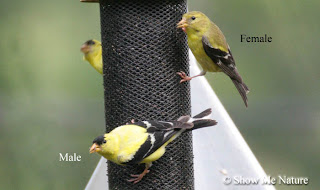A hatch year Goldfinch looks very different from his or her parents. In that same turn, male and female goldfinches also look different from each other. This difference in the feather colors between males and females is known as sexual dimorphism. During the summer, male goldfinches are bright yellow with a black head and wings. The females are a muted yellow, and lack the black head.
The young goldfinches were in various stages of learning to feed themselves. One little goldfinch begged his sibling for food...while on the bird feeder. But there was another young goldfinch that was beginning to master the art of foraging. This little one was plucking seeds off my Purple Coneflowers (Echinacea purepurea) in the backyard.
American Goldfinches nest later than other songbirds. Most birds breed late April through mid June but the goldfinches begin breeding in late June through July. These birds breed when milkweed, thistle and other plants have produced their fibrous seeds. The female builds the nest, usually in a shrub or sapling in a fairly open setting rather than within a forest. The nest is often built high in a shrub, where two or three vertical branches join; usually shaded by leaves of clusters of needles from above, but often open and visible from below. The nest is an open cup of plant fibers and rootlets and the interior is lined with the fluffy material surrounding the seed from thistle and other plants. The nest is so tightly woven that it can hold water.
Goldfinches are seed eaters, even during the breeding season. While most seed eaters, such as Sparrows, switch to an insect diet during the summer months, the goldfinches continue their seed eating diet and feed their young the seeds from trees, flowers, and shrubs.
You can find American Golfinches in parks, weedy fields, pastures, grasslands and in fields containing mature sunflowers. They will also eat from bird feeders that offer sunflower and thistle.
You may think that the bright yellow colors of the American Goldfinch really stand out - and indeed they do in a backyard while perched on a bird feeder. But out in a field of flowers, they are well camouflaged. Can you find the Goldfinch in this picture?
Be on the lookout for our pretty yellow feathered friends. If you are around a small field of, or even a cluster of dried flowers, the Goldfinches are sure to be nearby.
Glossary
Hatch Year: A bird that has hatched during the spring or summer. A young bird will be considered a hatch year bird until January 1st, when all are then considered adult birds.
Camouflage: The colors and markings of an animal or bird that allow it to blend in with its surroundings so as not to be detected by predators.





No comments:
Post a Comment